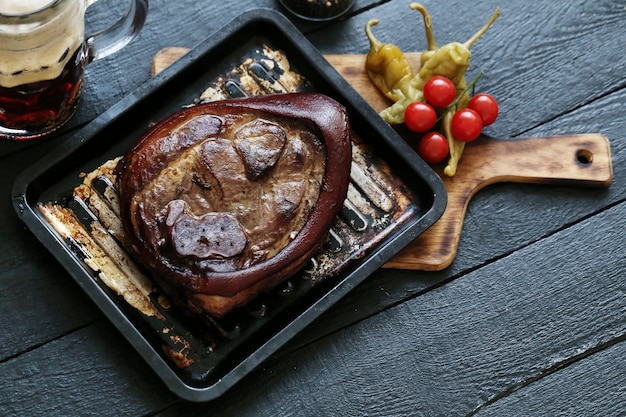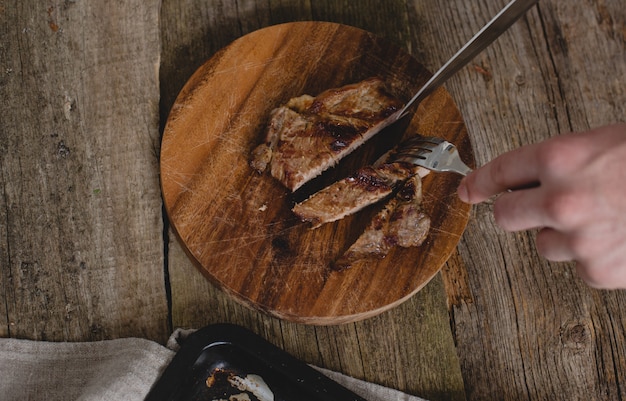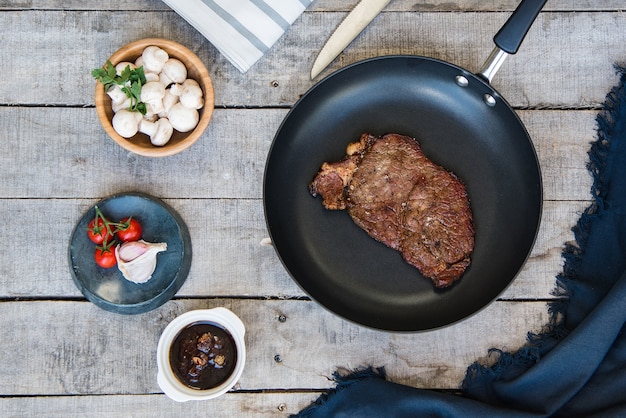Let me tell you, there's nothing quite like a perfectly pan-seared steak. That golden-brown crust, the juicy pink center, and the rich, savory aroma – it's a culinary symphony that always makes my mouth water. But for the longest time, I was convinced I couldn't make a decent steak at home. Those restaurant-worthy steaks seemed like a magical feat, beyond my amateur skills.
But then, one day, I decided to ditch the intimidation and give it a go. I armed myself with some basic knowledge, a good cast iron pan, and a whole lot of enthusiasm. And guess what? It wasn't rocket science! In fact, it was surprisingly simple and the results were absolutely delicious.
So, if you're a beginner, like I once was, don't let the idea of pan-searing steak scare you off. This comprehensive guide will walk you through every step, from choosing the right cut to achieving the perfect sear. Get ready to impress yourself and everyone else with your newfound steak-cooking prowess.
(Part 1) Picking the Perfect Cut: Your Steak's Foundation

The first step to making a stellar pan-seared steak is choosing the right cut of meat. It's like picking the perfect ingredients for any dish – it sets the foundation for success. And trust me, you don't want to skimp on this crucial step. A quality cut of meat is an investment worth making, especially when you're talking about pan-searing.
Choosing the Right Cut: A Steak Connoisseur's Guide
There are tons of steak cuts out there, each with its own unique character. But for pan-searing, a few cuts stand out as the perfect candidates due to their tenderness and flavor. Let's dive into a few of the most popular choices:
- Rib-Eye: The king of steaks, rib-eye is celebrated for its luxurious marbling and rich, buttery flavor. It's a bit more expensive, but for a special occasion, it's absolutely worth the splurge.
- new york strip: This cut boasts a flavor profile similar to rib-eye, but with a slightly leaner texture. It's a fantastic option if you're looking for a delicious steak without breaking the bank.
- Sirloin: A classic steak cut known for its leanness and versatility. It's great for grilling, pan-searing, or slicing into strips for stir-fries.
- Tenderloin: Also known as "filet mignon," tenderloin reigns supreme as the most tender cut of beef. It's a delicate beauty, possibly a bit more challenging to cook, but the taste is pure perfection.
Thickness and Temperature: Finding Your Ideal Doneness
The thickness of your steak will directly impact its cooking time. A thicker steak will take longer to cook through, while a thinner one will cook more quickly. And of course, you need to decide how you like your steak cooked – rare, medium-rare, medium, medium-well, or well-done?
Here's a handy guide to common steak temperatures:
| Level | Temperature (Internal) |
|---|---|
| Rare | 125°F (52°C) |
| Medium Rare | 130°F (54°C) |
| Medium | 140°F (60°C) |
| Medium Well | 150°F (65°C) |
| Well Done | 160°F (71°C) |
Remember, personal preference is key. I prefer my steak medium-rare, that juicy, pink center is my favorite! But if you like your steak well-done, that's totally fine – enjoy it your way!
(Part 2) Preparing the Steak: Setting the Stage for Success

Now that you've chosen your perfect cut, it's time to prep it for searing. This is your chance to showcase your culinary skills (or at least make it look like you know what you're doing).
Patting Dry and Seasoning: The Foundation of Flavor
The first step is to pat your steak dry with paper towels. This is crucial – it helps to create a beautiful, crispy crust and prevents the steak from steaming instead of searing.
Next, generously season your steak with salt and pepper. I'm a big fan of coarse salt and freshly ground black pepper, but you can use whatever you prefer. Don't be shy with the seasoning – a little extra never hurts!
Feeling adventurous? You can add other spices like garlic powder, onion powder, or paprika. Or try a steak rub. There are tons of recipes online, but I like to keep it simple with a blend of salt, pepper, and paprika.
Resting and Room Temperature: Giving Your Steak Time to Shine
Now comes an important step that many beginners overlook – resting the steak. It's essential to let the steak rest at room temperature for about 30 minutes before searing. This helps it cook more evenly and prevents it from becoming cold in the center while the outside cooks.
While your steak is resting, get your pan nice and hot. A cast iron skillet is ideal for pan-searing, but a heavy-bottomed stainless steel pan can work too. Heat your pan over medium-high heat for about 5 minutes, or until it's smoking hot. You want that pan to be seriously sizzling!
(Part 3) Searing the Steak: The Art of the Perfect Crust

Here comes the magic! The searing process is what gives the steak its incredibly delicious crust and that irresistible flavor.
Achieving the Perfect Sear: A Culinary Dance
Once your pan is smoking hot, add a tablespoon or two of oil. I typically use olive oil, but you can also use vegetable oil or canola oil. Let the oil heat up for a minute or two, then carefully add your steak to the pan.
Here's the golden rule: Don't touch the steak for at least 2-3 minutes! Let it develop that beautiful, crispy crust on the first side before flipping. Patience is key here!
Once that first side is perfectly browned, flip the steak over and sear the other side for another 2-3 minutes. Then, depending on your preferred level of doneness, continue searing the sides and edges for a few more minutes.
Using a Thermometer: A Steak's Best Friend
To ensure your steak is cooked to your liking, use a meat thermometer to check the internal temperature. Insert the thermometer into the thickest part of the steak, making sure it doesn't touch any bone.
Once the steak reaches your desired internal temperature, remove it from the pan and let it rest for at least 5 minutes before slicing and serving. This allows the juices to redistribute throughout the steak, resulting in a truly tender and juicy final product.
(Part 4) Resting and Serving: Celebrating Your Culinary Triumph
After all your hard work, it's time to enjoy the fruits of your labor. But before you dig in, you've gotta let that steak rest.
Resting the Steak: A Moment of Patience
Resting your steak is essential. It allows the juices to redistribute, making the steak more tender and juicy. Place the steak on a cutting board and cover it loosely with foil. Let it rest for 5-10 minutes before slicing and serving.
Serving Options: A Feast for the Senses
There are endless possibilities for serving a pan-seared steak. Here are a few ideas to get your creative juices flowing:
- Classic: Serve with mashed potatoes, roasted vegetables, and a side of gravy.
- French: Serve with frites (french fries) and a luxurious béarnaise sauce.
- Asian-Inspired: Serve with stir-fried vegetables and a side of rice.
- Mediterranean: Serve with grilled vegetables, couscous, and a bright lemon-herb sauce.
- Simple: Serve with a side salad and a great bottle of wine.
Remember, you can get as fancy or as simple as you like. The most important thing is to enjoy your delicious steak!
(Part 5) Tips and Tricks: Elevate Your Steak Game
Now that you've mastered the basics, here are a few tips and tricks that will take your pan-searing skills to the next level.
Temperature is King: The Key to a Perfect Crust
The key to a perfectly seared steak is a seriously hot pan. If your pan isn't scorching hot, the steak will steam instead of sear, and you'll miss out on that beautiful crust.
Don't Overcrowd the Pan: Space for Perfection
When you're searing your steak, don't overcrowd the pan. If you add too many steaks, the temperature will drop, and the steaks won't sear properly.
Don't Press on the Steak: Let It Breathe
Resist the urge to press down on the steak with your spatula. This will only squeeze out the juices and make the steak tougher.
Add Butter for Extra Flavor: A Touch of Luxury
For an extra burst of flavor, add a tablespoon or two of butter to the pan after you've removed the steak. Let the butter melt and sizzle, then spoon the melted butter over the steak.
Seasoning After Resting: Unlocking Maximum Flavor
You might be wondering, "Why season after resting?" Well, seasoning your steak too early can draw out moisture, resulting in a dry steak. The best time to season is right before slicing and serving, after the resting period.
(Part 6) FAQs: Common Steak-Related Questions Answered
Here are some common questions about pan-searing steak, answered:
1. What if I don't have a cast iron skillet?
No worries! You can still achieve a great sear using a heavy-bottomed stainless steel pan. Just make sure the pan is incredibly hot before you add the steak.
2. How do I tell if my steak is cooked to my liking?
Use a meat thermometer to check the internal temperature. Here's a quick guide to common steak temperatures:
| Level | Temperature (Internal) |
|---|---|
| Rare | 125°F (52°C) |
| Medium Rare | 130°F (54°C) |
| Medium | 140°F (60°C) |
| Medium Well | 150°F (65°C) |
| Well Done | 160°F (71°C) |
3. How long should I rest my steak?
Rest your steak for at least 5 minutes before slicing and serving. This allows the juices to redistribute throughout the steak, resulting in a more tender and juicy final product.
4. What if I overcook my steak?
Don't panic! It happens to the best of us. It doesn't mean it's ruined. You can still enjoy the steak, although it might be a bit tougher and drier than if it was cooked to your liking. Next time, use your trusty meat thermometer to avoid overcooking.
5. What are some good side dishes for steak?
The possibilities are endless! Here are a few of my personal favorites:
- Mashed Potatoes
- Roasted Vegetables
- Asparagus
- grilled corn on the Cob
- Macaroni and Cheese
It really depends on what you're in the mood for!
(Part 7) Beyond the Basics: Expanding Your Steak Horizon
Once you've mastered the basics of pan-searing steak, it's time to get creative and explore different techniques and flavors.
Experimenting with Spices: A Flavorful Adventure
Have fun playing around with different spices to find your perfect flavor combinations. Add a pinch of garlic powder, onion powder, paprika, or even a little chili powder to your steak. You can also experiment with herbs like thyme, rosemary, or oregano.
Adding a Glaze: A Touch of Sweet and Savory
For an extra layer of flavor and visual appeal, try adding a glaze to your steak. A simple glaze can be made with butter, honey, and soy sauce. But feel free to get creative with your glaze combinations! Try using ingredients like balsamic vinegar, mustard, or Worcestershire sauce.
reverse searing: Evenly Cooked, Crispy Perfection
Reverse searing is a technique that involves cooking the steak slowly in the oven before searing it in a pan. This results in a steak that's cooked evenly throughout and has a beautiful, crispy crust.
Sous Vide: Precision Cooking for Ultimate Tenderness
Sous vide is another fantastic method for cooking steak to perfection. It involves cooking the steak in a water bath at a precise temperature. This ensures that the steak is cooked evenly throughout, resulting in a steak that's incredibly tender and juicy.
(Part 8) Conclusion: steak mastery Achieved
Pan-searing steak is a skill that takes practice, but it's a rewarding one. With a little patience, attention to detail, and a sprinkle of confidence, you can create a mouthwatering steak that will impress even the most discerning palate.
So go ahead, give it a try! You might be surprised at how easy it is to create a perfect pan-seared steak at home. The world of steak awaits!
Everyone is watching

Prime Rib Roast Cooking Time Chart: Per Pound Guide
Cooking TipsPrime rib roast. Just the name conjures images of lavish dinners, crackling fires, and hearty laughter. It’s ...

How Long to Bake Potatoes in the Oven (Perfect Every Time)
Cooking TipsBaked potatoes are a staple in my kitchen. They're incredibly versatile, delicious, and surprisingly easy to m...

Perfect Rice Every Time: The Ultimate Guide to Cooking Rice
Cooking TipsAs a self-proclaimed foodie, I've always been a bit obsessed with rice. It's the foundation of countless cuisi...

The Ultimate Guide to Cooking Asparagus: Tips, Techniques, and Recipes
Cooking TipsAsparagus. The mere mention of this spring delicacy conjures up images of vibrant green spears, crisp and burs...

Ultimate Guide to Cooking the Perfect Thanksgiving Turkey
Cooking TipsThanksgiving. Just the word conjures up images of overflowing tables laden with delicious food, the scent of r...
